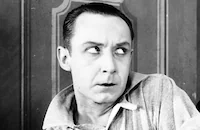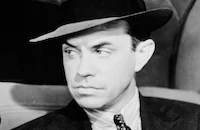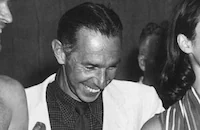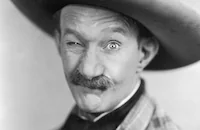Carefree

Brief Synopsis
Cast & Crew
Mark Sandrich
Fred Astaire
Ginger Rogers
Ralph Bellamy
Luella Gear
Jack Carson
Film Details
Technical Specs

Synopsis
Devastated that his fiancée, radio singer Amanda Cooper, has broken their engagement for the third time, lawyer Stephen Arden shows up drunk at the office of psychiatrist Dr. Tony Flagg, his best friend, and begs him to psychoanalyze Amanda. Reluctantly Tony agrees to see Amanda, but while the singer is waiting for him in his office, she accidentally overhears one of his dictaphone recordings in which he flippantly describes her as a dizzy, mindless female. Thus insulted, Amanda rebuffs Tony when they finally meet and leaves his office before the session has started. Later, Tony runs into Amanda, Stephen, Amanda's aunt Cora and Judge Joe Travers at the Medwick Country Club but is again snubbed by the singer. During an exhausting bicycle chase through the club park, Tony forces Amanda to reveal the reason for her anger and, after apologizing, tries to discuss her marriage phobia with her. Amanda, however, is unable to reveal the cause for her apprehension, and that night at dinner, Tony orders her a meal of "dreaming" food--outrageous combinations of rich dishes--to open up her subconscious. When Amanda still has difficulty falling asleep, Tony tells his assistant, Connors, to give her a sedative, which Cora then takes by mistake. Eventually Amanda falls asleep and dreams of an intensely romantic interlude between herself and Tony. The next day, however, Amanda shows up in Tony's office with Stephen and announces that their engagement is on again. Amanda then tries to tell Tony about her dream, but is so embarrassed by it that she makes up a convoluted, symbol-laden dream in which she is Little Red Riding Hood. Convinced that Amanda is a once-in-a-lifetime patient, Tony rushes to tell his colleague, Dr. Powers, about his discovery and prepares an injection of truth serum. After Amanda is injected, Stephen bursts into the examination room and informs her that she is late for a radio singing engagement. On the way to the studio, the drugged Amanda breaks a pane of glass and then insults the sponsor of the show on the air. When she then hits a policeman, she is arrested and brought before Judge Travers, who criticizes Tony's methodology but releases his patient. Later, Amanda admits to Cora that she loves Tony, but when she tries to break the news to Stephen, he assumes that he is the cherished man in question and immediately announces his engagement to a crowded restaurant. Amanda then tells Tony her true feelings, but out of loyalty for his friend, he submerges his emotions. Through hypnosis, he convinces Amanda that she loves Stephen and feels that the rest of manhood should be "shot down like dogs." Now desperate to be with Stephen, Amanda rushes to the country club where he and Judge Travers are practicing their skeet shooting. Seeing the judge, Amanda grabs a skeet rifle and starts shooting blindly at him, while shouting to Stephen that she adores him. When Tony finally confesses to Stephen that Amanda is in love with him, Stephen accuses his friend of trying to steal his fiancée and bars him from seeing her. On the eve of Stephen and Amanda's wedding, Tony connives with Connors to see Amanda alone, but his attempts to re-hypnotize her fail. At the wedding, however, Tony finds Amanda and, after first knocking out Stephen, knocks out Amanda and informs her subconscious that she really loves Tony. Cured at last of her marriage phobia, Amanda, black eye and all, walks down the aisle with Tony.

Director

Mark Sandrich
Cast

Fred Astaire

Ginger Rogers

Ralph Bellamy
Luella Gear

Jack Carson

Clarence Kolb

Franklin Pangborn

Walter Kingsford
Kay Sutton
Robert B. Mitchell And His St. Brendan`s Boys

Hattie Mcdaniel
Charles Coleman

Richard Lane

Paul Guilfoyle

Tom Tully
Edward Gargan

Jack Arnold
Frank Moran
James Burtis
Ted Manjean
Fred Sweeney
Jane Woodworth
Marge Nelon
George Denormand
Bobby Rose
Cliff Bergere
Dorothy Haas
L. Wood
Marek Wyndheim
Donald Kerr
H. Bailey
Phyllis Kennedy
Harold Minjir
B. Barbour
R. Ochman
Allan Scott
Jack Rice
Bert Morehouse
Bob Thatcher
Harry Campbell
Peggy Carroll

Jimmy Finlayson
Grace Hayle
Crew
Marian Ainslee
Victor Baravalle
Irving Berlin
Pandro S. Berman
Mel Berns
Hal Borne
Bill Brande
Carroll Clark
E. Cobb
Chuck Colean
Harry Cornbleth
Guy Endore
Fred Fleck
Les Goodwins
Robert De Grasse
Howard Greer
William Hamilton
Hugh Mcdowell Jr.
Argyle Nelson
Dudley Nichols
Ernest Pagano
Hermes Pan
Vasso Pan
Dorothy Panter
Van Nest Polglase
Allan Scott
Darrell Silvera
Edward Stevenson
W. Stewart
Vernon L. Walker
Hagar Wilde
Bill Williams

Photo Collections
Videos
Movie Clip





Hosted Intro
Film Details
Technical Specs

Award Nominations
Best Art Direction
Best Score
Best Song
Articles
Carefree
Carefree (1938), Astaire and Rogers' reunion film, was different from their previous collaborations. Closer in style to a screwball comedy than a musical, with only four musical numbers, Carefree focuses more on Rogers' character than on Astaire's. It's also the shortest Astaire-Rogers film, at 83 minutes. Rogers plays a radio singer who is reluctant to commit to marriage, so her boyfriend, Ralph Bellamy (in his standard boy-who-loses-the-girl role), takes her to psychiatrist Astaire to find out why. Naturally, Astaire and Rogers sing, dance, and fall in love to Irving Berlin tunes such as "Change Partners and Dance with Me," which was nominated for an Academy Award for Best Song. (The film was also nominated for Best Scoring and Best Art direction.)
The musical numbers were different, too. Astaire rarely lifted his partner in dances. In Carefree, he does so to great effect in two numbers, "I Used to be Color Blind," and "The Yam." In her autobiography, Rogers takes credit for coming up with the idea for the all-around-the-room lifts in the latter; dance critic Arlene Croce, in The Fred Astaire and Ginger Rogers Book, credits choreographer Hermes Pan. "I Used to be Color Blind" also contains a first for an Astaire-Rogers film: a kiss, a major lip-lock which seems to go on forever since it's played in slow motion. The lack of kisses in their previous screen romances was due to one of Astaire's quirks. He had an aversion to what he called "mushy love scenes," and thought it would be "somewhat novel" to confine their lovemaking to the dances. Then rumors began that Astaire's wife wouldn't let him kiss onscreen, or that he and Rogers disliked each other. So Astaire agreed to the long and languid smooch, "to make up for all the kisses I had not given Ginger for all those years." Another first was planned for Carefree, but never happened. It was supposed to be filmed in color -- hence, the "I Used to be Color Blind" number. But at the last moment, RKO decided color would be too expensive.
In spite of having the opportunity to use her comedy talents in Carefree, Rogers was unhappy about being forced to work again with director Mark Sandrich, who had directed four previous Astaire-Rogers films. She felt Sandrich bullied and patronized her and favored Astaire, and RKO had promised that Sandrich would never again be assigned to direct her. The studio mollified her with a raise, her favorite cinematographer, Robert de Grasse, and other concessions. And after Carefree, she never had to work with Sandrich again.
Carefree proved that the Astaire-Rogers magic was still potent. But as Arlene Croce wrote, "it is very much the twilight movie of the Astaire-Rogers series." There would be one more at RKO, The Story of Vernon and Irene Castle (1939), then Astaire left the studio, and Rogers went on to a non-musical career, earning an Academy Award for her performance in Kitty Foyle (1940). Their final RKO film would have been their last together, had not Judy Garland bowed out of The Barkleys of Broadway (1949) ten years later; instead, the movies' most popular dance team reunited for one last hurrah.
Director: Mark Sandrich
Producer: Pandro S. Berman
Screenplay: Allan Scott, Ernest Pagano; story and adaptation by Dudley Nichols & Hagar Wilde, based on an original idea by Marian Ainslee & Guy Endore
Editor: William Hamilton
Cinematography: Robert de Grasse
Costume Design: Edward Stevenson, Howard Greer
Art Direction: Van Nest Polglase, Carroll Clark
Music: Victor Baravalle; Songs by Irving Berlin
Principal Cast: Fred Astaire (Tony Flagg), Ginger Rogers (Amanda Cooper), Ralph Bellamy (Stephen Arden), Luella Gear (Aunt Cora), Jack Carson (Connors), Clarence Kolb (Judge Travers), Franklin Pangborn (Roland Hunter).
BW-84m. Closed captioning.
by Margarita Landazuri

Carefree
Quotes
Hattie, have you ever been married?- Aunt Cora
No Ma'am, but I been engaged.- Hattie
Oh, just as good.- Aunt Cora
No Ma'am... it's a lot better.- Hattie
"Dr. Flagg is a horrible monster! Men like him should be shot down like dogs! Shot down like dogs! Shot down like dogs!"- Amanda Cooper (under hypnosis)
Trivia
Notes
The late 1938 release of Carefree represented the longest gap between RKO's Fred Astaire/Ginger Rogers pictures and signalled the beginning of the end of their cinematic collaboration. Prior to making Carefree, Astaire made A Damsel in Distress without Rogers, while Rogers made Having Wonderful Time, Stage Door and Vivacious Lady without Astaire. Although Carefree received somewhat mixed reviews, Motion Picture Herald's William R. Weaver called it the "greatest Astaire-Rogers picture." Luella Gear, who had played "Hortense" in the stage version of The Gay Divorce, made her screen debut in the film. RKO borrowed Ralph Bellamy from Columbia for the picture. According to a Hollywood Reporter news item, Dave Dreyer, the head of RKO's music department, signed Ray Hendricks to sing Irving Berlin's "The Night Is Filled with Music" in the film. The number was dropped from the production, however, and the music is only heard as background filler. Hollywood Reporter production charts add William Corson to the cast, but his participation in the final film has not been confirmed. According to modern sources, Grace Hayle's part was cut from the film. The Variety reviewer noted that Robert Mitchell and the St. Brendan's Boys, popular Los Angeles radio performers, were edited out the picture as well. Location shooting was done at the Columbia Ranch and at Busch Gardens in Pasadena. Carefree was nominated for three Academy Awards: Van Nest Polglase and Carroll Clark for Best Art Direction, Victor Baravalle for Best Musical Score, and Irving Berlin for Best Song ("Change Partners").
Unlike the dances in previous Astaire-Rogers' films, the dances in Carefree, particularly the one performed to "I Used to Be Color Blind," used many lifts. In his autobiography, Astaire relates the following information about the production and the RKO series: "Pan[dro] Berman had already scheduled The Story of Vernon and Irene Castle to follow Carefree and that was to be the last of the series....I think we had as much fun with 'The Yam' as any number we ever did together. It was not exactly a dance for popular ballroom use but it made a good screen gimmick. 'I Used to Be Color Blind' was another one. We dreamed up a dream dance for that, partly in slow motion.... When we shot the dance for slow motion it of course was danced in normal fashion. But the special camera for that sort of thing sizzles away at four times faster speed, so that when the film is run normally, the action moves four times slower....For several years I had been planning a golf dance solo but could not find a suitable spot for it until Carefree came along. Fooling around at Bel Air one day, I did a few impromptu rhythm steps just before hitting one off the tee and was surprised to find that I could really connect that way....When I mentioned it to [director] Mark Sandrich for this story, he told me he thought it could be written in, but he wanted me to demonstrate what I had in mind. I took him to the practice tee at Bel Air....He approved. The next step was to set up a private driving range at the RKO ranch for rehearsals. I had about three hundred golf balls and five men shagging them, a piano and Hal Borne to play for me....This went on for two weeks...." Studio production files indicate that that sequence was shot from 14-15 April 1938, three weeks prior to the start of principal photography. Modern sources note that during the shoot, Astaire performed to Borne's piano accompaniment, and that orchestral sound was added in post-production.
Modern sources add the following information about the production: With the exception of "Change Partners," Berlin wrote the entire score for Carefree in a few days while on vacation in Phoenix, AZ. Berlin wrote "Change Partners" for Astaire and Rogers years before Carefree was produced. In addition to the omission of "The Night Is Filled with Music," a second dream sequence, which featured the Berlin song "Let's Make the Most of Our Dream," was filmed but deleted from the final picture. For the "I Used to Be Color Blind" sequence, which Berlin wrote with Technicolor in mind, color tests were made by the studio. When the tests proved unappealing, the idea of going from black and white to color during the dream was shelved. For Astaire's golf routine, internal edits were used for the first time in the RKO pictures. Astaire shot the more difficult parts of the routine several times and chose the best take for each one to give the illusion of a perfect performance. Carefree earned RKO $1,731,000 at the box office but ultimately lost the studio $68,000. According to Variety, RKO withdrew Carefree from theatrical circulation in 1980 because of perceived overexposure. Modern sources add Edward Gargan to the cast and credit Mel Berns as make-up artist and John Miehle as still photographer. For more information concerning the Astaire-Rogers RKO films, see entry for Top Hat.

Miscellaneous Notes
Released in United States 1938
Released in United States on Video April 20, 1994
Released in United States 1938
Released in United States on Video April 20, 1994















